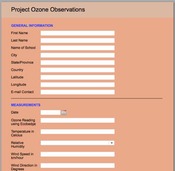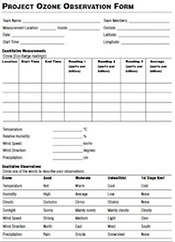Ozone, A Global Project
Students use the Project Ozone Web site to collaborate with other schools on the problem of ozone and share data in order to gain knowledge about ozone at the global level. Students also discuss what can be done to halt the trend toward increasing urban smog levels.
Data Transmission. Once the data have been compiled, student teams submit their data to the Project Ozone Database. From the Project Ozone home page, students select “Data Sharing.” Students will be able to enter their data directly into a Data Sharing form and send it electronically to the Project Ozone Database. The submission form for Project Ozone is shown here.
Data Access. From the Project Ozone home page, select “Data Access” and down-load the data that appears in the Ozone data table. You can open the downloaded data in programs such as Excel. Using Excel, students can use graphing and map tools to answer their questions. Have the students stick pins on the world map for each location rep-resented in the data. Discuss the results as a class. Have students draw comparisons among the reporting cities to explain differences in levels of ozone.
Have students write brief analyses of the data, using their graphs and maps to support their deas. Have students share the results in class, perhaps in the form of a conference. Students can also post their results on the Project Ozone Weblog accessed from the Ozone home page.



